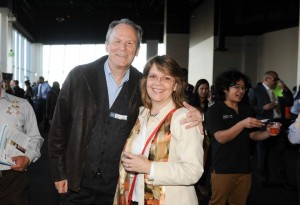The post Sustainability in Business appeared first on Paul Terry & Associates.
]]>Financial sustainability is a must for any small business’ survival and long-term success. But socially and environmentally responsible business practices are also essential if we want our businesses and communities to thrive.
What does “sustainability” mean for a small business?
It could mean…
• Offering employees great working conditions, paying competitive wages, and/or providing educational options and opportunities for advancement.
• Creating and/or selling products produced in ways that minimize harm to the environment and preserve resources.
• Sourcing materials locally and supporting local industries.
• Operating transparently – sharing data and treating competitors as colleagues.
• Giving back to the local community – donating profits to a charitable purpose, mentoring other small business owners, etc.
Sustainability has certainly become a buzzword in business. Yet when implemented in real ways, it not only benefits the wider community but can have positive benefits for your business directly – attracting new customers and committed employees and increasing efficiency and profit.
We asked some of our clients and colleagues about their sustainability practices. They shared their advice for other small business owners who want to incorporating sustainable practices into their businesses.
Rachel Lewin of RxOrganics
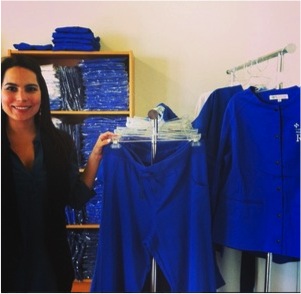
Sustainability is central to Rachel Lewin’s business RxOrganics, which locally manufactures “green” kitchen and medical garments. Rachel’s sustainable business practices give her a competitive edge by distinguishing her products in the uniform/professional wear marketplace.
For Rachel, sustainability is not just a marketing tool. She is always thinking about the environmental impact of every decision, from her supply chain to her end products. Tracking and measuring those practices is also central to her operation.
“It is integral to maintaining our “green” certification status with the city and various accrediting agencies to have all of our efforts clearly documented. We are constantly checking our systems to make sure that we can confidently sell our values to our customers and end users, and seeking additional certifications related to sustainable and socially responsible business practices. We are currently seeking a Higg Index score for our manufacturing practice.”
Rachel’s advice to other business owners: Be sustainable from the start and track what you do!
“It is much easier to scale responsibly if you build your foundation sustainably. Keep it simple and clear and document all your steps and actions — even the little unglamorous ones, like changing your toilets and water faucets to low flow. It all adds up! Ultimately the customers appreciate a mindful organization over a cheap one. You’ll see!”
Melissa Joy Manning of Melissa Joy Manning Jewelry
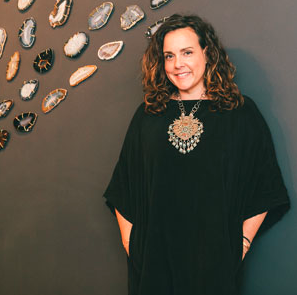
When jeweler Melissa Joy Manning started her business, Melissa Joy Manning Jewelry, in 1997 she wanted to create jobs for other artists: “I distinctly remember being told that I could never operate a business in such a competitive market with on-shore labor. Thankfully, I followed my heart and built a business around a local community. Now “American Made” is a driving marketing force in our industry and we lead the fashion industry in responsible practice.”
Sustainable practices are central to both jewelry production and packaging at Melissa Joy Manning. They use only 100% recycled metal sourced from a “green” certified US refiner, their precious stones follow the Kimberly Process, and they are buying more of their stones directly from mine owners to have true clarity on their gem chain of custody. Additionally all MJM packaging is recycled, jewelry pouches are made in the US from certified responsible felt, and MJM carbon offsets every box shipped to neutralize their carbon footprint.
For Melissa, though, the most important sustainable business practices relate to the reason why she went into business in the first place. All Melissa Joy Manning jewelry is hand made in her own studios in New York and Berkeley by artists earning a living working wage, with full benefits, competitive bonuses and retirement packages.
Melissa’s advice to other business owners: Start small!
“Make little changes that can be easily incorporated into your business practices. You can then add or change your practices to increase your sustainability. It can be incredibly intimidating to try and change everything at once. Starting small, however, leads to greater, more successful cumulative change that can be grown as the business can afford it. In the long run being responsible is not only more efficient and sustainable, it is cheaper and leads to greater profit and stronger ties to your market.”
Gwen Kaplan of Ace Mailing

Gwen Kaplan, CEO and founder of Ace Mailing, has been focused on sustainability since founding her direct mail business almost 40 years ago. When she was president of the Small Business Commission in the late 1980’s she started the Green Ribbon Panel which provided small businesses with sustainable or “green” solutions and recognized San Francisco green businesses. (This panel ultimately became the San Francisco Department of the Environment.) Ace Mailing was the first company in the US to sell recycled paper retail in bulk cartons for copy machines. Since 2007, Ace Mailing has been carbon neutral through TIST and the Institute for Environmental Innovation.
Gwen’s advice to other business owners: Evolve!
“Ace Mailing is continually living, breathing and changing to meet the needs of our clients.”. Sustainability requires strategic evolution of your business. Focus on your target market and meet their needs to achieve long-term sustainability.
Ultimately, it is important to remember that…
There are many ways to create a sustainable and responsible business. The sustainable practices that you decide to employ will be unique to your type of business and your style of doing business.
Instituting new business practices may not be easy or quick to implement. Changing how you operate takes commitment, and often time and money to get new ways of operating established.
Creating a more sustainable business is a process. As Mark Dwight, founder of Rickshaw Bagworks in San Francisco says in this Inc Magazine article, “Sustainability is a journey, not a destination.”
The first step is to just take a step! As Melissa says, choose one small way to improve your practices. Implement that practice into your business and see the results. (This is what business action planning is all about.) You will learn from it and build on it!
How is YOUR business embracing sustainable practices?
The post Sustainability in Business appeared first on Paul Terry & Associates.
]]>The post Business Exit… have you thought about it? appeared first on Paul Terry & Associates.
]]>
Don’t wait. Think about a business exit now.
No matter how successful you are in business and how much you love our work, you should think about what will happen to your business when you no longer actively manage or run it. At some point down the road—a couple of years or decades from now—you will leave your businesses (or your businesses will leave you). Personal circumstances might change or burn-out could happen. You may be ready to pursue a new endeavor or want to retire. Or someone could approach you about buying your business.
Business exit options
You may not be able to predict your business’ success, your future interests, or the direction of the marketplace. But you can start thinking about the business exit options that could be a good fit for you.
There are a variety of ways to exit your business. You could pass it to a family member, partner, employee or other business stakeholder. You could sell it to an outsider. You could liquidate it and sell the assets, or you could file for bankruptcy.
How will you figure out what is best for you and your business?
Envisioning the future
We encourage you to think about the future of your business and what it might look like when you are not at the helm.
- Is your goal to create a legacy business that will last forever?
- Do you ultimately want to pass the business on to a family member?
- When you are ready to stop running the business, do you hope to sell it?
- Would you want the business taken over by an employee(s), partner or other internal stakeholder or would you want to sell to an outside party?
The vision for your business will change as your business develops and circumstances change, but thinking about your business’ trajectory, including your exit, is a key part of strategic planning and business growth. (If you are in a business partnership, it is important that you have an ownership agreement, from the beginning, that spells out what will happen if one or more partners wants to exit the business.)
Planning your transition
When you are ready to think seriously about transitioning away from your business, you need a business exit plan. Just as a good business plan is an important part of business start-up, a good exit plan is key to a smooth transition away from the business.
We help our clients through the transition planning process. This includes identifying or clarifying your motivations and goals, assessing the current strengths and weaknesses of the business, and creating a role transition or business sale timeline with clear benchmarks. We then help business owners stay accountable to their plan.
Our goal is to help small business owners feel ready for their next steps, with a feasible and straightforward plan to guide them through their transition. Learn more about our ownership transition consulting services.
The post Business Exit… have you thought about it? appeared first on Paul Terry & Associates.
]]>The post Do you have an entrepreneurial dream? appeared first on Paul Terry & Associates.
]]>
“When it came to launching my own business, I needed a plan. I couldn’t just work it out on a cocktail napkin. I needed time to think it through. I might be brave and adventurous, but I’m also very methodical.
An entrepreneurial friend told me that she’d registered for a Business Planning Class at the San Francisco Renaissance Entrepreneurship Center. They offered a 14-week planning session to help entrepreneurs work on their business plan and give their idea wings.
So I decided to register… I worked on firming up my idea, looking at it from all angles, and finally creating a robust business plan that would set me up for success.
I can’t recommend the RenCenter enough. Today it has offices in SF, the Peninsula, and Marin, with more small business incubators for new entrepreneurs. Sharon Miller is an amazing CEO and visionary. Their instructors are brilliant (special shout out to my mentor, Paul Terry) and the support is amazing. They are not your Shark Tanks.”
(thanks for the shout-out, Josiane!)
Now, Josiane wants to encourage others who are passionate about a business idea and ready to take the plunge. TeleSmart Communications is offering a scholarship to one lucky person who would like to register for Renaissance Entrepreneurship Center’s 14-week business planning class in 2015.
Do you have an entrepreneurial dream? Click here to learn more about TeleSmart’s scholarship opportunity!
The post Do you have an entrepreneurial dream? appeared first on Paul Terry & Associates.
]]>The post Rock, paper, wisdom appeared first on Paul Terry & Associates.
]]>
Each stone, with its special design and word of inspiration, is unique and the process of making them is a labor of love.
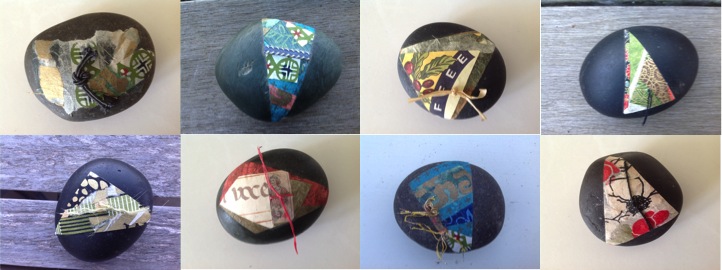
Every year my wife, Leslie, creates a new stone design. Together we select river rocks that are the right size and color, we wash and scrub them, I apply linseed oil to bring out their rich hue, and then Leslie glues interesting handmade papers to each rock, often incorporating string or twine. The last step in the process is adding a word of wisdom to the back of each stone.
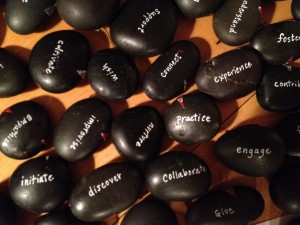
After so many years of making these stones together and sending them off into the community, we started to wonder… where do they end up and what do they mean to people?
So we asked. Here is some of what we found out…
They decorate people’s bookshelves, tables and mantels:
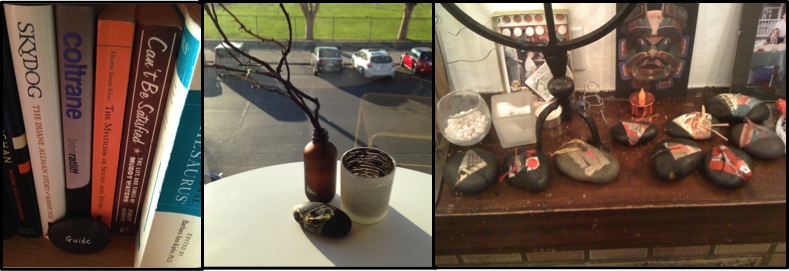
They live in the office, the bathroom and the garden:

And they can be found in many rooms throughout peoples’ houses:
“One is on my table, another on my bookshelf, a fourth by my meditation area, and a fifth by my bedside.”
“The chaos of my life always benefits from having a few wisdom stones nearby. And yes, they are in every room of my house. Almost.”
For some people, the stones are decoration. For others, they are continued inspiration. One colleague keeps her wisdom stones in her office and they inspire her communication with her clients. Another colleague shared, “I sometimes have a client pick up a rock to guide our consulting session if they are stuck on some issue: it breaks them into a smile!”
This colleague used her wisdom stones at a party once as a way to introduce people to each other. Each party guest read a word on a rock and shared what it meant for them, which made for some fun ice breaker introductions. She then mused that if she could remember which rock she received on which year, it would be interesting to look at the words of wisdom and see how they matched the trajectory of her business and her business growth.
It has been fun to see where these stones have ended up and what they mean to people. For me, making the stones and then giving them away is a way to connect to community… sharing small objects of beauty that bring joy and inspiration to those around me.
If you have ever received a PTA wisdom stone, please let me know what it means to you.
The post Rock, paper, wisdom appeared first on Paul Terry & Associates.
]]>The post Yoga and Small Business Week appeared first on Paul Terry & Associates.
]]>At the kick-off celebration, Flavors of San Francisco, last Monday the Cityview Room of the Metreon was filled with great food from over 30 San Francisco restaurants and catering companies. The room was packed with small business owners and supporters. I got a chance to connect and catch up with Mark Quinn from SBA, Gwen Kaplan of Ace Mailing, PTA Associates Ken Stram and Monika Hudson, and Lisa Kirvin from Renaissance Entrepreneurship Center.
On Wednesday, as part of the Small Business Conference at San Francisco State, I gave a workshop on Business Planning 101+ to a crowd of about 100 people. Things got off to a rocky start. (There always has to be a tech problem, right?) The PowerPoint presentation wouldn’t work so I got everyone on their feet for a little yoga… and a chance to get to know each other. Then, with a some help from the SBW tech staff and Renaissance’s Executive Director Sharon Miller, we got back on track.
I focused my talk on the basics of business planning and eight critical success factors for a small business launch (more on that soon). I also shared student stories from Renaissance Entrepreneurship Center’s 14-week business planning class, including Neil Gottlieb of Three Twins Ice Cream, Judi Henderson-Townsend of Mannequin Madness, Zel Anders of Tomboy Tailors and Lori Shannon of See Jane Run.
The room was full of people with small business ideas eager to take their business concepts to the next level. It was fun to share stories and help motivate them to take the leap of faith into small business ownership. The point is to s-t-r-e-t-c-h, focus, and make it happen!
The post Yoga and Small Business Week appeared first on Paul Terry & Associates.
]]>The post Advocating for Small Business appeared first on Paul Terry & Associates.
]]> On Thursday May 9th a very happy crowd gathered at the Marine’s Memorial Club in San Francisco for the Small Business Network’s Annual Awards Gala. Mayor Ed Lee was there at the start to welcome us all and emphasize his support for many new small business initiatives in the city.
On Thursday May 9th a very happy crowd gathered at the Marine’s Memorial Club in San Francisco for the Small Business Network’s Annual Awards Gala. Mayor Ed Lee was there at the start to welcome us all and emphasize his support for many new small business initiatives in the city.
I was honored to be one of the nine award winners, receiving the Small Business Advocate Award for my role as a small business owner and my involvement in the small business community for the past 30+ years. My business friend and long-term client, Kayren Hudiburgh, co-owner of The Good Life Grocery, was kind enough to introduce me and relate all the many years of our work together, both on her business and in the Potrero and Bernal Heights communities.
I got my start by owning and selling four businesses—a wholesale distribution company, two retail food businesses and a training seminar business. I then founded Paul Terry & Associates to help others start and manage their own small businesses. I see my role as an advocate—encouraging and supporting the passion and commitment of small business owners while providing tools and advice to create a sound foundation for success. I love working with business owners at every stage—teaching business planning to entrepreneurs getting ready to launch their businesses, and working with established small business clients through all stages of their business growth.
I have benefited greatly from wonderful mentors, loyal colleagues and supportive organizations and I enjoy doing everything I can to support the local small business community, particularly working with Renaissance Entrepreneurship Center and business associations such as the Potrero Dogpatch Merchants Association and the California Association for Micro Enterprise Opportunity. For me, community service and advocacy is simply a part of what it means to be a socially responsible small business owner.
The post Advocating for Small Business appeared first on Paul Terry & Associates.
]]>The post Outstanding Service appeared first on Paul Terry & Associates.
]]>
receiving the Renaissance Outstanding Service Award
It was such an honor to receive this award in front of colleagues, students, friends and family during Renaissance’s gala event, “Small Business, Big Impact: Celebrating 28 Years of Small Business Success” on October 2nd at the Bently Reserve in San Francisco.
It was quite surprising to realize that I have taught over 5,000 business planning students and supported over 100 incubator tenants at Renaissance. The secret is that I’m constantly inspired working with new and emerging business owners. I love the experience of helping students to explore options, get organized, develop practical business skills and take the steps necessary to make their small businesses work. I am inspired each day by the diversity of people who want to start their own businesses, the variety of business ideas, students’ focus and passion, as well as their willingness to put in the time and make the commitment to be successful.
While the award was so appreciated, the people who truly deserve the accolades are the Renaissance graduates — the new entrepreneurs who are doing research, creating prototypes, testing concepts, launching on a trial basis, and then jumping into the marketplace.
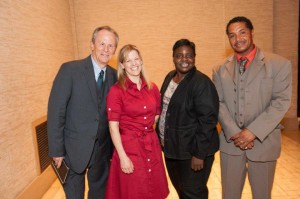
with fellow Renaissance graduate award winners, Heidi Gibson, Yvonne Hines and Alphonso Rhodes
These small and micro businesses are the engines of our local and national economy. We need to support them so they can thrive, continue to expand, offer jobs, and become community-based institutions for our neighborhoods and cities. When you choose to frequent small, independently owned businesses you are directly building the local economy and, in the process, supporting some amazing, dynamic people. Our small business owners are heroes. They are making a difference through their focus on sustainability and their attention to the local community. We need to award the local, small business owner for outstanding service!
The post Outstanding Service appeared first on Paul Terry & Associates.
]]>The post Time for Action: Seven Steps appeared first on Paul Terry & Associates.
]]>Does any of this sound familiar:
- you feel pressured and overwhelmed with too many tasks and not enough time
- you work harder than anyone else with endless meetings, calls and interruptions
- you have ideas on how to improve but no time to implement.
Therefore, you become paralyzed, tend to sabotage, procrastinate or simply give up. All of the above conditions are a common reality. There is simply too much to do and simply not enough time to do it. There is no one who is available to help you and only you, of course, can really do it right anyway. So the only other solution … you stretch, juggle and squeeze!

However, it is possible to get things done without such a “squeeze”. You can change and learn to work smarter so you can meet deadlines, be creative and then celebrate each success with a reward. You can start right away with one successful strategy and build from there. Pick a routine, a time management tool, or office procedure. Make it something simple and easy to initiate. Then include a monitoring or reward system to acknowledge that you have made this technique your routine and it is making a difference. We are talking about CHANGING BEHAVIOR…and we can do it one step at a time.
Here are seven simple suggestions that, if implemented, can really help:
1. Write out a goal that is very specific and measurable. (You want to open your business for the holidays. You must be ready with inventory and marketing collateral by the end of August or you will be too late.)
2. Use the master “to-do” list and match each task to pre-set goals. (Use a prioritized list of very specific action steps each with an estimated start date AND completion date).
3. Prioritize your “to-do” list based on effective criteria that will help your business now. (Make sales calls to new and old clients before you procrastinate to file old client files.)
4. Eliminate unproductive meetings or any personal phone calls during the business day. (Have meetings early in the day and make personal calls after 5 p.m or not at all.)
5. Establish a predetermined place where you get things done efficiently (For example, try to answer all calls right at your desk near client files when you first arrive at work and make all appointments right there).
6. Revise your plans constructively. If something doesn’t work out, you have learned from a “mistake”. (Learn from your OWN experience. This is NOT a failure but a discovery of what didn’t work. Take this lesson learned and change your next action accordingly.)
7. Take your predetermined reward. (Set up a reward in advance for your efforts. When you have achieved the “success” that you have set for that hour, day or week and take the reward when you are “done”).
Plan and use your time well. If your business is to be exciting and profitable, your attention to developing time management expertise will have a significant impact on your success!
The post Time for Action: Seven Steps appeared first on Paul Terry & Associates.
]]>The post A Boom for Micro Businesses: Can You Deliver? appeared first on Paul Terry & Associates.
]]>
There are reports about local food-related and clothing-centric businesses that seem to suggest there are key trends to watch for – not only new and innovative products but how they are being distributed. Gail Lillian, owner of Liba Falafel has leveraged her food truck serving falafels into a stand-alone restaurant business with her recent expansion plans for Oakland. “The truck helped determine the market and build the right business skills – with key access points around the SF Bay Area.”
Micro entrepreneurs are reaching out to the markets – the specific, targeted niche markets that seem to respond to what is being offered and to clients and customers who are willing to pay for the quality or uniqueness of the service. There are pop-up shops and consignment retailers; there are food trucks; food stalls and food kiosks at the corner of your street and in the farmer’s markets. There are neighborhood street fairs for clothing lines and third world imports.
There are many, many “distribution channels”…and there are more and more businesses that are succeeding online with well-designed websites too. Laurie Kanes runs 12 Small Things, an on-line business providing access for artisans from many developing countries. Her focus and purpose is to “showcase and sell fashionable, fair trade products from artisans facing some of the most challenging conditions in the world”. This socially relevant business is targeting a niche and to do it well, must also execute and provide impeccable service. Laurie notes, “My competitive edge is to develop key partnerships to access the right markets and support the right artisans”.
Are these trends helpful to you and your micro businesses? We DO need to know who will buy our products and services; we DO have to be accessible, we DO have to tell our stories so people will be interested in what we have not just once, but over and over again.
However, the basic truth is we have to deliver – meet a promise and provide a benefit – and then build trust. Do what you say you are going to do and take the action to make it work well…again and again. Every new business requires an initial ignition but then after that first spark, we provide the consistent follow-through over and over again!
The business action plan that we use individually and with small groups is an excellent tool to make this happen for any small business.
Let’s see how well we can grow when we “deliver the goods”.
The post A Boom for Micro Businesses: Can You Deliver? appeared first on Paul Terry & Associates.
]]>